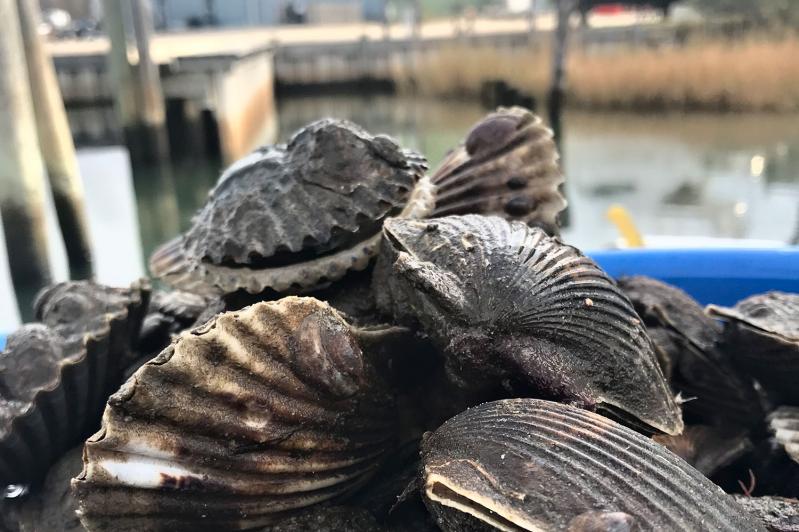A lot of people are keeping an eye out, but from all that I've seen and heard so far this summer, the water clarity in the creeks, estuaries, harbors, and bays has been rather good. Beyond dirty water, especially at low tide, churned up by the wake of heavy boat traffic, commercial baymen and other interests claim that no unsightly brown, rust, or red tides have blossomed thus far. But then again, we did not witness any of such scourges last summer, when basically every adult bay scallop died.
Although the exact cause of the die-off is unknown, scientists theorize that the mortality event was due to physiological stress during bay scallop spawning, which was exacerbated by high summer water temperatures (mid-80s) and low dissolved oxygen. In addition, back in January, the New York State Department of Environmental Conservation announced the detection of a coccidian parasite in a sample of bay scallops collected from the Peconic Bays.
It marked the first reported detection of a coccidian parasite in bay scallops associated with a large-scale mortality event. While the parasite is not harmful to humans and does not pose a public health threat, scientists believe it can significantly affect the bay scallop fishery. In 2018, about 110,000 pounds of scallops were harvested. While the final 2019 total has not yet been released, it is expected to be well under 10,000 pounds.
I have heard some early reports that this year's scallop crop, which hatched last June and survived the mystery onslaught while their parents died, are alive and doing well along the bay bottoms. The dozen or so juveniles that I sprinkled around my dock last fall in my own little marine biology experiment, also seem to be happy and well-fed, feasting on the life-giving plankton that abounds when I can view them near low tide. So far, so good.
"Unlike oysters and clams, scallops are very fickle and are a challenge to raise," Kim Tetrault of East Hampton, who oversees the oyster spat program at the Cornell Cooperative Extension Center in Southold, said when I saw him in early June to pick up my seed oysters. "I too have heard that there are scallops in the bay, but only time will tell."
It's certainly good news right now, but fingers are being tightly crossed that the precious and popular bivalve continues to flourish until the season opens up in November. For now, it's all in the hands of good old Mother Nature. A lot can happen in the next three months.
As for the fishing scene this week: "Not a whole lot to get terribly excited about," sighed Ken Morse at Tight Lines Tackle in Sag Harbor. "Some bluefish have reappeared at Jessup's Neck and there are weakfish in the deep water in Noyac Bay." Morse did add that those fishing to the east at the Race have done well with striped bass and large bluefish.
Over at the Tackle Shop, the owner, Harvey Bennett, remarked that fishing is holding up, despite the midsummer heat. "There are lots of blowfish in Three Mile Harbor, Accabonac Harbor, and at the dock in Fort Pond Bay, where porgies are mixed in."
Bennett said that while fluke fishing has been on the slow side, porgies remain reliable in many locales.
He had a good fish story to share on Monday morning.
"A guy came into the shop on Saturday and said he was fishing off the ocean beach in Napeague," he said. "He caught some schoolie bass, but then a large fish inhaled the small diamond jig he was casting."
After fighting the fish for over 30 minutes up and down the beach, Bennett said, the angler made a dreaded mistake. "He tightened up the drag and popped the line. He had fresh 30-pound braid line on the reel which is really strong stuff too, so it had to be something big."
Bennett figures it was probably a small bluefin tuna. "Some guys the day before caught them only a few miles off Amagansett where a dragger was working," he said. "I remember we used to get bluefins when I was younger at this time of the year not far off the beach too."
Alas, it's a story familiar story to about every angler, a story of the big one that got away.
But the big ones, tuna that is, have indeed been landed in rather sizable quantities of late. The Viking Fivestar ran out to deep water offshore for a three-day trip last weekend, but only needed 12 hours to boat 32 yellowfin and bigeye tuna. According to Capt. Steven Forsberg Jr., it was an "absolutely epic trip."
Those fishing closer to home, anywhere between 6 and 12 miles south of the Montauk Lighthouse, report good action on thresher, mako, and hammerhead sharks. Bluefin tuna, including the one that possibly got away on Saturday, are also in the mix.
As for the Montauk fluke bite, the action has been consistent of late, with some nice-size fish up to nine pounds landed. "The action has been very good with all good-quality fish," said Capt. Mark Ryckman of the Montauk Star, a full-day party boat. "There is a lot of bait in the area and a lot of life. We are also getting some sea bass, cod, and ling too."
Ryckman also shared his story of one that got away from Saturday's trip. "One of my regular customers, Richie Negron, hooked into a blue marlin while dropping his bait to the bottom. He didn't have it on for long, but it made a tail-dance or two on the surface before it broke the line. Now that's very unusual."
And a good fish story too.

